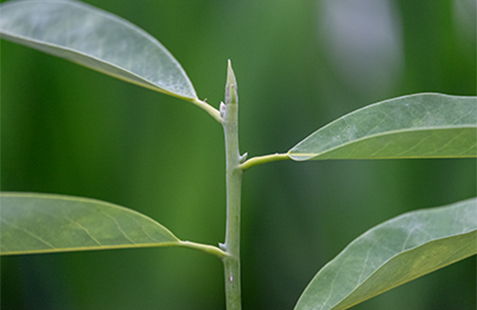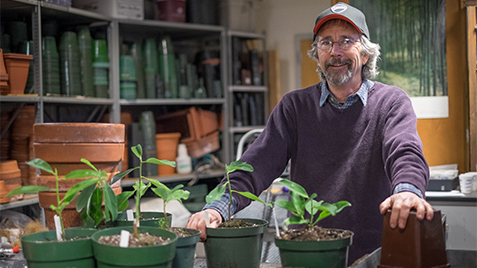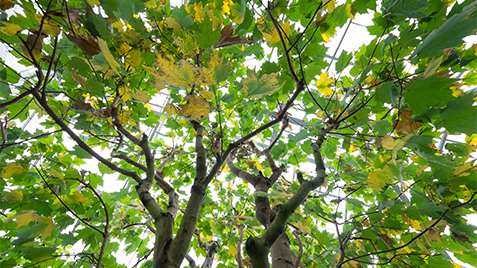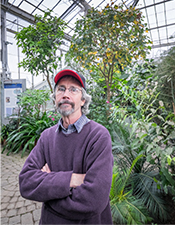

Helping to protect endangered species like this rare magnolia is one of the most gratifying aspects of Rob Nicholson’s work as manager at Smith’s Lyman Conservatory. Nicholson and a group of students collected samples of the rare plant in a swamp in Gloucester, Mass.
/ Published January 14, 2015
An Aztec curse seemed like a minor obstacle as Rob Nicholson, manager for the Lyman Conservatory of the Botanic Garden of Smith College, climbed a monkey-hand tree in Oaxaca, Mexico, to gather plant samples. The Aztecs forbade the plucking of the tree’s fruit and revered the medicinal properties of its hand-like flower. But Nicholson had long hoped to collect the plant’s seed. He made his way toward the oblong pods on the upper boughs. Who believes in an ancient curse, anyway?
Then the branch broke.
Nicholson’s son, along for the expedition and then just 14 years old, “was devastated. He thought I was dead, because I was knocked out,” says Nicholson. “He still doesn’t like to talk about it.”
After that, Nicholson decided to leave the monkey-hand fruit alone.
Nicholson’s collecting trips have taken him all over the world. As conservatory manager, he oversees efforts to propagate and share the plants he has collected as well as those he receives from other botanists for research and preservation efforts. The plants are housed in the Lyman Conservatory or sent to arboretums and conservatories in the United States and overseas. Nicholson also curates the conservatory’s collection of more than 2,500 plant species. That includes managing the annual bulb and chrysanthemum shows, which attract tens of thousands of visitors to the conservatory each year.
On one average day, Nicholson is found not up a tree but in the more prosaic surroundings of the conservatory’s potting room. A smell of soil pervades the room. On the shelves is a clutter of clay pots, watering cans, twine and industrial-sized bags of vermiculite and soil. On a lab bench sprouts a garden of paper cups, each filled with plant matter. Nearby, four pots of tiny conifers no greater than knee height—Cupressus atlantica and Taiwania cryptomerioides—are marked “Polly Hill Arboretum, Monday pick-up.”

In the conservatory’s potting room, Rob Nicholson pots a rare magnolia from a stand reportedly once visited by Henry David Thoreau.
This is Nicholson’s daily world, and he’s hard at work. Those paper cups contain seeds and spores collected from fruiting plants in the conservatory. They’ll be sent to an international seed exchange with 350 participating botanic gardens.
Many of Nicholson’s samples are rare or endangered species, which he tries to propagate and disseminate. Cupressus atlantica is an endangered Moroccan cypress, endemic to a single river basin in the Atlas mountains. Recently, Nicholson explains, Smith student Jacqueline Maasch ’16 managed to propagate this cypress and several other rare trees. The Taiwania cryptomerioides, too, is a member of the cypress family and has become endangered due to illegal logging in its native China and Taiwan. The saplings are destined for other arboretums, where they will be protected in case the wild populations go extinct.
“A lot of times, the most critically endangered stuff isn’t going to live in New England,” Nicholson says. “We have a pretty rough climate here. What we seem to be good at is getting material, propagating it and then finding a good home for it.”
Nicholson’s expeditions have often formed the basis for this work. In the 1990s, he collected a cloud-forest sugar maple in the Mexican biosphere preserve El Cielo. A relative of the familiar, colorful New England tree, the Mexican maple is the rarest species in North America. But Nicholson’s collected tree proved resistant to propagation. For years, it stood as a single exemplar in the Lyman Conservatory, one of only two known wild-collected cloud-forest sugar maples in the country.
This year, however, Nicholson and Maasch managed to propagate the maple using extremely high-strength hormone treatments on cuttings. They’re now working with the U.S. National Arboretum in Washington, D.C., to conduct molecular genetic analysis on the tree to learn more about its genetic makeup.
Through the analysis, Nicholson also hopes to discover how the cloud-forest sugar maple adapted to climate change. Maples likely first migrated to Mexico during glacial periods. It’s unclear whether they’ve now kept the hardiness to cold of their northern cousins. Genetic work might answer this and other questions about how the species has changed.
Such plant collection, says Nicholson, frequently offers unexpected opportunities for collaboration. “You might collect a plant ... and it might sit there for 20, 30, 50 years, and then it suddenly becomes an important tool for someone’s research,” he says. From his El Cielo trip, “five of the plants I collected in that one day ended up in peer-reviewed research papers, because we were the only ones who had them.”
The samples from the collecting expeditions spawn work in medicinal therapy research, genetic analyses and horticultural breeding.
In 2003, for example, Nicholson and his colleagues analyzed a Mexican yew, Taxus globosa, for possible medicinal use. Close relatives of the yew were known to contain a potent anticancer compound called taxol. But the genetic diversity of the Taxus genus, as well as which species contained the most taxol, remained unknown.
Nicholson and his collaborators gathered Taxus species from Scandinavia, the Philippines, Vietnam, Korea and Mexico. The Mexican Taxus globosa plant material they collected and analyzed contained over 35 percent more taxol than any previously tested Taxus species—potentially making the tree a new economic crop for Mexico. The work, co-authored with Mexican collaborator Eduardo Estrada, was published in Botánica Económica y Etnobotánica.

With the help of Jacqueline Maasch ’16, Nicholson has successfully propagated a cloud-forest sugar maple from a sample he collected in Mexico in the 1990s. It is one of only two known wild-collected samples of this tree in the United States.
But Nicholson is proudest of his work in protecting endangered species. One tree that he collected in Florida, the stinking cedar or Torreya taxifolia, is expected to become extinct in the wild. Only a few hundred wild trees remain. Nicholson’s efforts have produced thousands of rooted cuttings now housed in botanic gardens and preserves worldwide.
Botanic gardens, he says, must now play a greater role in harboring such species.
“Given the way population growth and climate change are coupling to create a decline in wild areas and to change conditions so quickly that plants can’t migrate or adapt, we’re going to see more and more plants be listed as endangered,” he says. “I don’t know that botanic gardens have risen to that challenge to the degree they should, yet.”


















